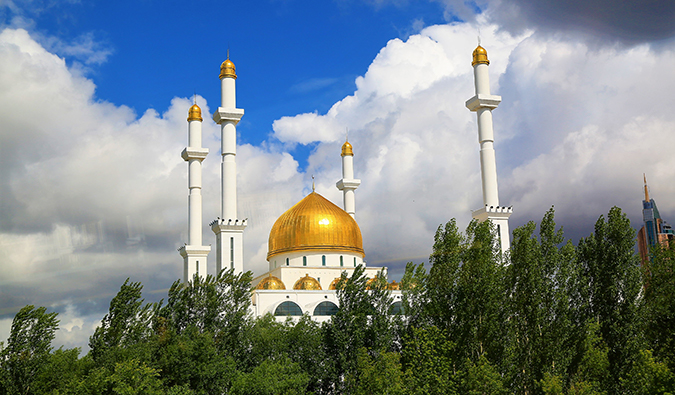 Posted: 11/18/19 | November 18th, 2019
Kazakhstan is a country I’ve always wanted to visit. In fact, I’ve always wanted to go to all the “Stans”. It’s the region of the world I probably want to visit the most. After having lived in Kazakhstan for 8 years, Doug Fears knows a thing or two about the country and how to navigate it. In this guest post, Doug offers some in-depth advice about how to travel around Kazakhstan by train!
Night spilled across the Kazakh steppe. The train’s steel wheels clickety-clacked below, gently prompting me to point toward a bowl of plastic-wrapped apples. Suddenly, my drunken dining car companion began gesticulating wildly while repeating his favorite, and perhaps only, English-language phrase, “No problem!” With a shake of the head and wave of the hand, this newfound friend seemed to dismiss all other apples as second-rate. Apples originated from Kazakhstan, after all, and we had just departed the city of Almaty, “the father of apples.” I simply had to try one. (It was delicious.)
Taking the train through Kazakhstan, the world’s ninth largest country, presents a changing cultural tapestry every time. Imagine a vast land, once secretive and closed to outsiders, where travelers can now experience an eclectic blend of Silk Road culture, offbeat Soviet-era history, and wide-open spaces spiced with warm Kazakh hospitality.
I’ve shared cabins with young soldiers, border police, language professors and martial artists, just to name a few. My favorite memories are the meals and card games enjoyed with these folks, even when I didn’t have a common language.
So forget everything about the movie Borat, and climb aboard as you browse ancient bazaars, ride the rails, and trek to pristine mountain lakes.
Posted: 11/18/19 | November 18th, 2019
Kazakhstan is a country I’ve always wanted to visit. In fact, I’ve always wanted to go to all the “Stans”. It’s the region of the world I probably want to visit the most. After having lived in Kazakhstan for 8 years, Doug Fears knows a thing or two about the country and how to navigate it. In this guest post, Doug offers some in-depth advice about how to travel around Kazakhstan by train!
Night spilled across the Kazakh steppe. The train’s steel wheels clickety-clacked below, gently prompting me to point toward a bowl of plastic-wrapped apples. Suddenly, my drunken dining car companion began gesticulating wildly while repeating his favorite, and perhaps only, English-language phrase, “No problem!” With a shake of the head and wave of the hand, this newfound friend seemed to dismiss all other apples as second-rate. Apples originated from Kazakhstan, after all, and we had just departed the city of Almaty, “the father of apples.” I simply had to try one. (It was delicious.)
Taking the train through Kazakhstan, the world’s ninth largest country, presents a changing cultural tapestry every time. Imagine a vast land, once secretive and closed to outsiders, where travelers can now experience an eclectic blend of Silk Road culture, offbeat Soviet-era history, and wide-open spaces spiced with warm Kazakh hospitality.
I’ve shared cabins with young soldiers, border police, language professors and martial artists, just to name a few. My favorite memories are the meals and card games enjoyed with these folks, even when I didn’t have a common language.
So forget everything about the movie Borat, and climb aboard as you browse ancient bazaars, ride the rails, and trek to pristine mountain lakes.
Planning Your Route
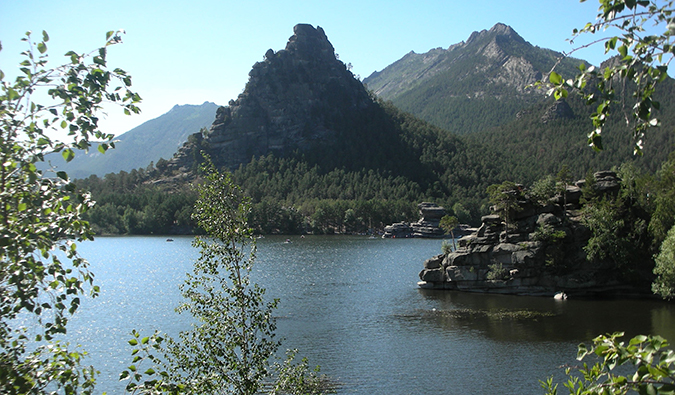 I suggest the following itinerary: flying into the capital, Nur-Sultan (formerly Astana) (airport code TSE), heading north to nearby Lake Burabay, taking a fast train back south to Karaganda, then an overnight classic train to Almaty in the southeast, with a possible extension to Turkistan (a city and region in the south of the country).
If you want to continue on in Central Asia, you can easily extend your trip from Almaty to see the gorgeous mountain vistas of nearby Kyrgyzstan or continue by train from Turkistan south to Uzbekistan.
The best time to go is between May and October, as northern Kazakhstan is blanketed in snow from November through April, with typical temps in the minus-20 range. Those wanting to snow ski or experience the excitement of New Year’s, the country’s biggest holiday, however, should consider a wintertime trip.
Visas are no longer needed for most visitors to Kazakhstan (for 30 days) and Kyrgyzstan (for 60 days), though advance visas are required for Uzbekistan, Russia, and China.
I suggest the following itinerary: flying into the capital, Nur-Sultan (formerly Astana) (airport code TSE), heading north to nearby Lake Burabay, taking a fast train back south to Karaganda, then an overnight classic train to Almaty in the southeast, with a possible extension to Turkistan (a city and region in the south of the country).
If you want to continue on in Central Asia, you can easily extend your trip from Almaty to see the gorgeous mountain vistas of nearby Kyrgyzstan or continue by train from Turkistan south to Uzbekistan.
The best time to go is between May and October, as northern Kazakhstan is blanketed in snow from November through April, with typical temps in the minus-20 range. Those wanting to snow ski or experience the excitement of New Year’s, the country’s biggest holiday, however, should consider a wintertime trip.
Visas are no longer needed for most visitors to Kazakhstan (for 30 days) and Kyrgyzstan (for 60 days), though advance visas are required for Uzbekistan, Russia, and China.
Buying Train Tickets
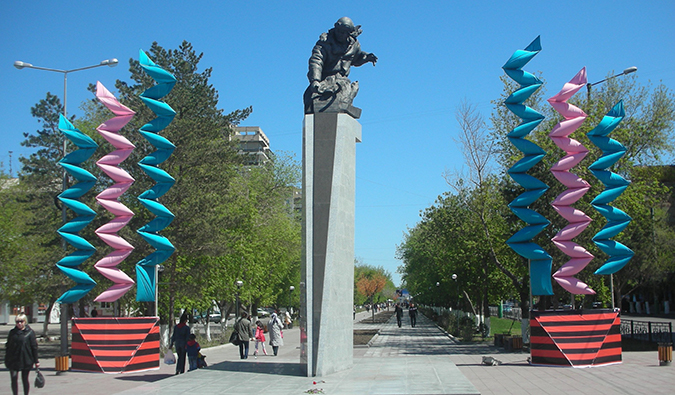 There are three types of trains: the fast business-class Talgo, regular long-distance trains, and regional electrics. Budget travelers should opt for regular trains for most trips. Regional electrics are generally slow and will be of limited use.
On regular trains — highly recommended for the best cultural experience — the two main classes are kupe (a four-person closed compartment with two upper and lower bunks) and platzkar (an open rolling dormitory holding 54 travelers on two-level bunks). The kupe is quieter and more private, but single women might want to choose the somewhat safer open platzkar, as they could be in a locked cabin with three men (no gender distinctions are made when making reservations). Also realize that not all trains run daily.
The new Kazakhstan e-ticket website is not easy to use: while there is an English menu, it requires you to enter destination cities using a Russian keyboard! Some foreign bankcards won’t work for payment, and even successful ticket purchases are often blocked by spam filters. However, there is an option to chat online with an English-language consultant who can help you find and purchase tickets.
My suggestion is to use this site as a reference to find train timetables and to purchase long-distance train tickets that are more likely to be sold out. You can use the helpful site Real Russia for international train ticket purchases (especially for traveling from Moscow to Central Asia).
Then go to a train station or train ticket office in the city, as some have kiosk machines that you can try. Another option is to write your destination and date on a piece of paper and present it to a ticket agent at a station or train office for help.
Once you have your ticket, the most important things to know are the date and time of departure, and wagon number. Check the posted signs in the station to find which platform number your train is on and walk toward that wagon — the conductor will check your ID and ticket and help you board.
There are three types of trains: the fast business-class Talgo, regular long-distance trains, and regional electrics. Budget travelers should opt for regular trains for most trips. Regional electrics are generally slow and will be of limited use.
On regular trains — highly recommended for the best cultural experience — the two main classes are kupe (a four-person closed compartment with two upper and lower bunks) and platzkar (an open rolling dormitory holding 54 travelers on two-level bunks). The kupe is quieter and more private, but single women might want to choose the somewhat safer open platzkar, as they could be in a locked cabin with three men (no gender distinctions are made when making reservations). Also realize that not all trains run daily.
The new Kazakhstan e-ticket website is not easy to use: while there is an English menu, it requires you to enter destination cities using a Russian keyboard! Some foreign bankcards won’t work for payment, and even successful ticket purchases are often blocked by spam filters. However, there is an option to chat online with an English-language consultant who can help you find and purchase tickets.
My suggestion is to use this site as a reference to find train timetables and to purchase long-distance train tickets that are more likely to be sold out. You can use the helpful site Real Russia for international train ticket purchases (especially for traveling from Moscow to Central Asia).
Then go to a train station or train ticket office in the city, as some have kiosk machines that you can try. Another option is to write your destination and date on a piece of paper and present it to a ticket agent at a station or train office for help.
Once you have your ticket, the most important things to know are the date and time of departure, and wagon number. Check the posted signs in the station to find which platform number your train is on and walk toward that wagon — the conductor will check your ID and ticket and help you board.
Kazakhstan Costs
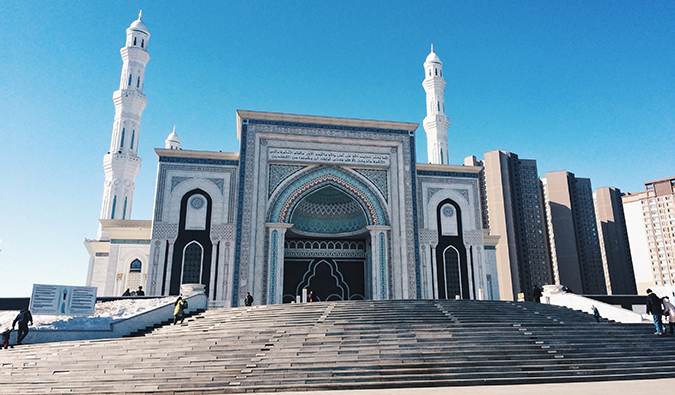 Traveling by train is much safer and enjoyable than by bus, and an incredible value for the long distances traveled. A standard overnight train ticket from Karaganda to Almaty will be about $9 USD for platzkar and $14 for kupe. By comparison, the business-class Talgo on the same route costs $25 in a four-berth kupe, but it does reduce travel time by six hours (and has much cleaner bathrooms!). A night train provides double value, serving as both bed and transport; they are cooler and more comfortable in the summer travel season too!
Local city buses are cheap, about $0.20 per ride, regardless of distance.
Hotel rooms in the city centers of Nur-Sultan and Almaty range from $30 to $50 per night with breakfast. Full apartments ($25/night) or shared guest rooms ($10/night) can be booked on Airbnb.
Food is also reasonably priced. I suggest finding a hotel with breakfast included on booking.com, eating picnic-style meals on the train, and enjoying a streetside café for other meals (grilled shashlik skewers, bread, salad, and drink for about $4), though if you can’t peel it or cook it, it’s best to forget it. And make sure to try the local apples!
Traveling by train is much safer and enjoyable than by bus, and an incredible value for the long distances traveled. A standard overnight train ticket from Karaganda to Almaty will be about $9 USD for platzkar and $14 for kupe. By comparison, the business-class Talgo on the same route costs $25 in a four-berth kupe, but it does reduce travel time by six hours (and has much cleaner bathrooms!). A night train provides double value, serving as both bed and transport; they are cooler and more comfortable in the summer travel season too!
Local city buses are cheap, about $0.20 per ride, regardless of distance.
Hotel rooms in the city centers of Nur-Sultan and Almaty range from $30 to $50 per night with breakfast. Full apartments ($25/night) or shared guest rooms ($10/night) can be booked on Airbnb.
Food is also reasonably priced. I suggest finding a hotel with breakfast included on booking.com, eating picnic-style meals on the train, and enjoying a streetside café for other meals (grilled shashlik skewers, bread, salad, and drink for about $4), though if you can’t peel it or cook it, it’s best to forget it. And make sure to try the local apples!
Essential Kazakhstan Travel Hacks
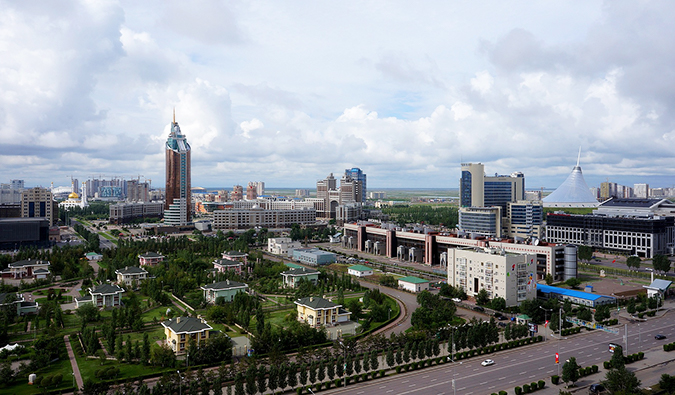
- Do reserve an upper bunk if you like relaxing onboard (lower bunks are shared during the daytime and used for communal meals), but you need to be reasonably fit to climb the mini-ladder.
- Do bring a comfortable change of clothes to wear onboard (track suit, shorts, and T-shirt). It’s perfectly normal to ask others to step outside while you change.
- Do bring extra food to share (tea/coffee, instant noodles, sausage, cucumbers, bread, biscuits, apples, sweets). Note: there is always a steaming samovar of hot water in each car for making tea or noodles.
- Do pack a small train kit (mug, fork/spoon/knife, toilet paper, plate, wet wipes, plastic sandals, collapsible hand fan, deck of cards, bottled water).
- Do take your street shoes off when entering a train compartment.
- Do plan your bathroom visits, as the toilets are locked about 15 minutes before and after station stops (read the timetable posted in each wagon).
- Do take some small gifts from your home country (magnets, key rings) to share.
- Don’t buy unsold seats from touts lurking around stations — I’ve been stuck sharing a four-berth kupe with six people plus a giant-screen TV!
- Don’t get scolded for lying on a bare mattress, but don’t pay extra for sheets and towels in kupe class. They are now included in the kupe ticket fare, but beware you may be awakened very early by the conductor collecting them on overnight trains!
- Don’t be bullied by transport police or immigration officials at borders — show your passport and ticket and nothing more.
- Don’t miss your stop, get stranded on the platform buying ice cream, or, above all, be forced to jump off a moving train!
Best Kazakhstan Train Routes
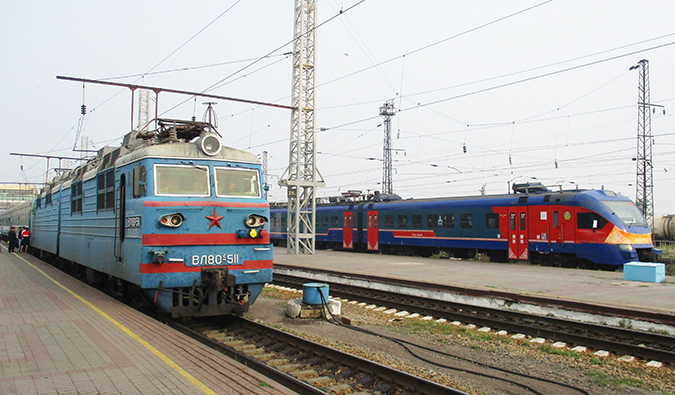 Because of the challenges with the ticketing website, I’ve listed the most helpful train routes for getting around. Note that all of these run daily.
While northbound trains from Nur-Sultan stop at Borovoye/Shchuchinsk, it might be easier to take a shared van or minibus for the short 2.5-hour trip. Just listen or ask for “Borovoye” at the Nur-Sultan-1 train station, where vans wait to fill up and leave throughout the day. You can do the same if heading directly south from Nur-Sultan to Karaganda, as a new tollway has opened, cutting the travel time between these two major cities to two hours, although all Nur-Sultan-to-Almaty trains also stop there. Note that both Nur-Sultan and Almaty have two train stations in different parts of the city — make sure you go to the right one!
Train #031 from Almaty to Semey in the northeast traces the historical “TurkSib” route — from here you can head east to explore the Altay Mountains or continue north into Russia to connect with the legendary Trans-Siberian route.
Because of the challenges with the ticketing website, I’ve listed the most helpful train routes for getting around. Note that all of these run daily.
While northbound trains from Nur-Sultan stop at Borovoye/Shchuchinsk, it might be easier to take a shared van or minibus for the short 2.5-hour trip. Just listen or ask for “Borovoye” at the Nur-Sultan-1 train station, where vans wait to fill up and leave throughout the day. You can do the same if heading directly south from Nur-Sultan to Karaganda, as a new tollway has opened, cutting the travel time between these two major cities to two hours, although all Nur-Sultan-to-Almaty trains also stop there. Note that both Nur-Sultan and Almaty have two train stations in different parts of the city — make sure you go to the right one!
Train #031 from Almaty to Semey in the northeast traces the historical “TurkSib” route — from here you can head east to explore the Altay Mountains or continue north into Russia to connect with the legendary Trans-Siberian route.
Route
Train No.
Departs
Arrives
Cost
Nur-Sultan-1 –
Borovoye
(Lake Burabay)
705 Talgo
07:56
10:04
$13
(4p kupe)
Borovoye –
Karaganda
706 Talgo
18:40
23:41
$14
(4p kupe)
$16 (2p)
Nur-Sultan NurlyZhol –
Karaganda
Almaty-1
010
20:10
23:22
14:40+1
$7platzkar
$10kupe
$18platzkar
$28kupe
Almaty-1 –
Nur-Sultan NurlyZhol
009
17:38
12:34+1
$18
(platzkar)
$28 (kupe)
Almaty-2 –
Turkistan
071
21:08
10:47+1
$18 (kupe)
Almaty-2 –
Semey
031 Talgo
13:25
07:52+1
$24 (kupe)
What to See Along the Way
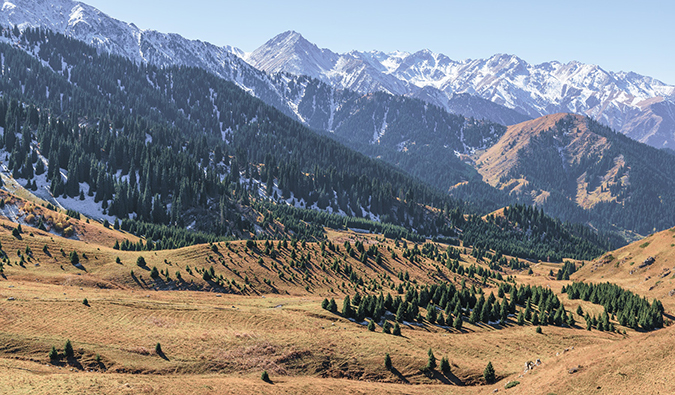 The major cities of Nur-Sultan, Karaganda, and Almaty are all on the main rail line and make both good stopovers and bases for exploring the surrounding natural and historical sites. Other off-the-beaten-track locations, such as the Baykonur rocket base and Altay Mountains, require special permission and advance planning. Here’s an overview of the major destinations:
The major cities of Nur-Sultan, Karaganda, and Almaty are all on the main rail line and make both good stopovers and bases for exploring the surrounding natural and historical sites. Other off-the-beaten-track locations, such as the Baykonur rocket base and Altay Mountains, require special permission and advance planning. Here’s an overview of the major destinations:
- Nur-Sultan, formerly Astana) – one of the world’s youngest capital cities, a futuristic Tomorrowland-esqe blend of gleaming buildings, shopping centers, and sculpted monuments.
- Lake Burabay (formerly Borovoye) – a scenic, forested lake resort just 2.5 hours north of Nur-Sultan, featuring a wide range of accommodations and attractions.
- Karaganda – Kazakhstan’s “third city,” with its leafy wide boulevards, is a good base for exploring Soviet-era history, particularly the museum of political repression at nearby Dolinka, one of the largest labor camps in the Gulag system.
- Almaty – Central Asia’s most cosmopolitan city. The stunning backdrop of the Tien Shan Mountains frames this busy business center, a great base for making day trips to the nearby mountains, the skate/ski center at Medeu/Chimbulak, and the red rock Charyn Canyon.
- Turkistan – Kazakhstan’s holiest site, and the country’s best place to see Silk Road architecture and tile work.
- Baykonur Cosmodrome – the world’s most active launch site for manned space missions. Rocket enthusiasts will need to book well in advance with an agency like Nomadic Travel Kazakhstan to try and see a launch.
- The Far Northeast – Well off the beaten path, Semey, Ust-Kamenogorsk, and the pristine Altay Mountains are in a beautiful region worth the extra effort to see. Visiting the sensitive border zone or former Polygon nuclear test site will require special permits and advance planning.
Book Your Trip: Logistical Tips and Tricks
Book Your Flight Find a cheap flight by using Skyscanner or Momondo. They are my two favorite search engines because they search websites and airlines around the globe, so you always know no stone is being left unturned. Book Your Accommodation You can book your hostel with Hostelworld as they have the largest inventory. If you want to stay somewhere other than a hostel, use Booking.com, as it consistently returns the cheapest rates for guesthouses and cheap hotels. I use them both all the time. Don’t Forget Travel Insurance Travel insurance will protect you against illness, injury, theft, and cancellations. It’s comprehensive protection in case anything goes wrong. I never go on a trip without it, as I’ve had to use it many times in the past. I’ve been using World Nomads for ten years. My favorite companies that offer the best service and value are:- World Nomads (for everyone below 70)
- Insure My Trip (for those over 70)